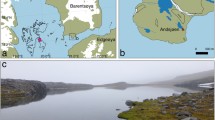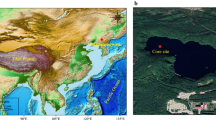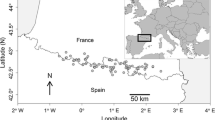Abstract
In the last decade, much effort was dedicated to the reconstruction of past climate at high temporal resolution. Here, we show the suitability of chrysophyte cysts from lake sediments for revealing continental climate variability when used in sensitive sites, such as those in high mountains. We demonstrate that altitude is a main factor influencing the present distribution of chrysophytes and develop a transfer function to evaluate the local “altitude anomaly” on a lake site throughout time. Based on our knowledge of chrysophyte ecology, the altitude anomalies are interpreted as winter/spring climate signatures. The method was applied to a Holocene record from a lake in the Pyrenees showing submillennial climatic variability in this northwestern Mediterranean zone. A warming trend was present from the early Holocene to 4 kyear BP. Comparison with pollen-based reconstructions of summer temperatures denoted a contrasting decrease in continentality between the two parts of the Holocene. Oscillations of 1 cycle per ca. 2,000 years appeared throughout the record. The warmest Holocene winters were recorded during the Medieval Warm Period at ca. AD 900 and 450 and the Roman Warm Period (2.7–2.4 kyear BP). Winters in the period AD 1,050–1,175 were inferred to be as cold as in the Little Ice Age. The period between 3 and 7 kyear BP showed lower intensity in the fluctuations than in early and late Holocene. The cold event, 8,200 years ago, appeared embedded in a warm fluctuation. Another cold fluctuation was recorded around 9 kyear BP, which is in agreement with Irish and Greenland records.













Similar content being viewed by others
References
Agustí-Panareda A, Thompson R (2002) Retrodiction of air temperature at eleven remote Alpine and Arctic lakes in Europe from 1781 to 1997. J Paleolimnol 28:7–23
Alley RB, Mayewsky PA, Sowers T, Stuiver M, Taylor KC, Clark PU (1997) Holocene climatic instability: a prominent, widespread event 8200 yr ago. Geology 25:483–486
Appleby PG, Oldfield F (1978) The calculation of 210Pb dates assuming a constant rate of supply of unsupported 210Pb to the sediment. Catena 5:1–8
Barber DC, Dyke A, Hillaire-Marcel C, Jennings AE, Andrews JT, Kerwin MW, Bilodeau G, McNeely R, Southon J, Morehead MD, Gagnon JM (1999) Forcing of the cold event of 8200 years ago by catastrophic drainage of Laurentide lakes. Nature 400:344–348
Bard E, Raisbeck G, Yiou F, Jouzel J (2000) Solar irradiance during the last 1200 years based on cosmogenic nuclides. Tellus B 52:985–992
Battarbee RW (1986) Diatom analysis. In: Berglund BE (ed) Handbook of Holocene palaeoecology and palaeohydrology. Wiley, Chichester, pp 527–570
Battarbee RW, Grytnes JA, Thompson R, Appleby PG, Catalan J, Korhola A, Birks JB, Lami A (2002) Climate variability and ecosystem dynamics at remote alpine and arctic lakes: the last 200 years. J Paleolimnol 28:161–179
Berger A (1978) Long-term variations of daily insolation and Quaternary climatic changes. J Atmos Sci 35:2362–2367
Betts-Piper AM, Zeeb BA, Smol JP (2004) Distribution and autoecology of chrysophyte cysts from High Arctic Svalbard Lakes: preliminary evidence of recent environmental change. J Paleolimnol 31:467–481
Bigler C, Hall RI (2002) Diatoms as indicators of climatic and limnological change in Swedish Lapland: a 100 lake calibration set and its validation for paleoecological reconstruction. J Paleolimnol 27:97–115
Birks HJB (1995) Quantitative palaeoenvironmental reconstructions. In: Maddy D, Brew JS (eds) Statistical modelling of quaternary science data. Cambridge University Press, Cambridge, pp 161–254
Birks HJB (1998) Numerical tools in palaeolimnology—progress, potentialities, and problems. J Paleolimnol 20:307–332
Birks HJB, Line JM, Juggins S, Stevenson AC, ter Braak CJF (1990) Diatoms and pH reconstruction. Phil Trans R Soc Lond B 327:263–268
Bloom A, Moser KA, Porinchu DF, MacDonald GM (2003) Diatom-inference models for surface-water temperature and salinity developed from a 57-lake calibration set from the Sierra Nevada, California, USA. J Paleolimnol 29:235–255
Bond G, Showers W, Cheseby M, Lotti R, Almasi P, deMenocal P, Priore P, Cullen H, Hajdas I, Bonani G (1997) A pervasive millennial-scale cycle in North Atlantic Holocene and glacial climates. Science 278:1257–1266
Borcard D, Legendre P, Drapeau P (1992) Partialing out the spatial component of ecological variation. Ecology 73:1045–1055
Broecker WS (2001) Was the Medieval warm period global? Science 291:1497–1499
Cacho I, Grimalt JO, Pelegero C, Canals M, Sierro FJ, Flores AJ, Shakelton NJ (1999) Daansgaard-Oeschger and Heinrich event imprints in Alboran Sea paleotemperatures. Paleoceanography 14:698–705
Camarero L, Masqué P, Devos W, Ani-Ragolta I, Catalan J, Moor HC, Pla S, Sanchez-Cabeza JA (1998) Historical variations in lead fluxes in the Pyrenees (Northeast Spain) from a dated lake sediment core. Water Air Soil Pol 105:439–449
Catalan J (1988) Physical properties of the environment relevant to the pelagic ecosystem dynamics of a deep high-mountain lake (Estany Redó, Pyrenees) Oecol Aquat 9:89–123
Catalan J (2000) Primary production in a high mountain lake: an overview from minutes to kiloyears. Atti Associazione Italiana Oceanologia Limnologia 13:1–21
Catalan J, Ballesteros E, Gacia E, Palau A, Camarero L (1993) Chemical composition of disturbed and undisturbed high-mountain lakes in the Pyrenees: a reference for acidified sites. Water Res 27:113–141
Cheddadi R, Yu G, Guiot J, Harrison SP, Prentice IC (1996) The climate of Europe 6000 years ago. Clim Dyn 13:1–9
Cronberg G, Sandgren CD (1986) A proposal for the development of standardized nomenclature and terminology for chrysophycean statospores. In: Kristiansen J, Andersen RA (eds) Chrysophytes: aspects and problems. Cambridge University Press, Cambridge, pp 317–328
deMenocal P, Ortiz J, Guilderson T, Adkins J, Sarnthein M, Baker L, Yarusinsky M (2000) Abrupt onset and termination of the African Humid Period: rapid climate responses to gradual insolation forcing. Quaternary Sci Rev 19:347–361
Duff KE, Zeeb BA, Smol JP (1995) Atlas of chrysophycean cysts. Kluwer, Dordrecht
Eloranta P (1995) Biogeography of chrysophytes in Finish lakes. In: Sandgren CD, Smol JP, Kristiansen J (eds) Chrysophyte algae. Ecology, phylogeny and development. Cambridge University Press, Cambridge, pp 214–231
Felip M, Bartumeus F, Halac S, Catalan J (1999) Microbial plankton assemblages, composition and biomass, during two ice-free periods in a deep high mountain lake (Estany Redó, Pyrenees). J Limnol 58:193–202
Gasse F (2000) Hydrological changes in the African tropics since the Last Glacial Maximum. Quaternary Sci Rev 19:189–211
Grimm EC (1987) CONISS: a FORTRAM 77 program for stratigraphically constrained cluster analysis by the method of incremental sum of squares. Comput Geosci 13:13–35
Grootes PM, Stuiver M, White JWC, Johnsen SJ, Jouzel J (1993) Comparison of oxygen isotope records from the GISP2 and GRIP Greenland ice cores. Nature 366:552–554
Guiot J (1990) Methodology of paleoclimatic reconstruction from pollen in France. Palaeogeogr Palaeoclimatol Palaeoecol 80:49–69
Heiri O, Lotter AF, Lemcke G (2001) Loss on ignition as a method for estimating organic and carbonate content in sediments: reproducibility and comparability of results. J Paleolimnol 25:101–110
Heiri O, Lotter AF, Hausmann S, Kienast F (2003) A chironomid-based Holocene summer air temperature reconstruction from the Swiss Alps. Holocene 13:477–484
Jongman RHG, ter Braak CJF, Van Tongeren OFR (1995) Data analysis in community and landscape ecology. Cambridge University Press, Cambridge
Kamenik C (2001) Chrysophyte resting stages in mountain lakes: indicators of human impact and climate change. PhD thesis, University of Innsbruck
Kamenik C, Schmidt R, Koinig KA, Agustí-Panareda A, Thompson R, Psenner R (2001) The chrysophyte stomatocyst composition in a high alpine lake (Gossenkollesee, Tyrol) in relation to seasonality, temperature and land-use. Nova Hedwigia 122:1–22
Larocque I, Hall RI, Grahn E (2001) Chironomids as indicators of climate change: a 100-lake training set from a subartic region of northern Sweden (Lapland). J Paleolimnol 26:307–322
Livingstone DM, Lotter AF (1998) The relationship between air and water temperatures in lakes of the Swiss Plateau: a case study with palaeolimnological implications. J Paleolimnol 19:181–198
Lotter AF, Birks HJB, Hofmann W, Marchetto A (1997) Modern cladocera, chironomid, diatom, and chrysophyte cyst assemblages as quantitative indicators for the reconstruction of past environmental conditions in the Alps. I. Climate. J Paleolimnol 18:395–420
Lotter AF, Birks HJB, Eicher U, Hofmann W, Schwander J, Wick L (2000) Younger Dryas and Allerød summer temperatures at Gerzensee (Switzerland) inferred from fossil pollen and cladoceran assemblages. Palaeogeogr Palaeoclimatol Palaeoecol 159:349–361
Luterbacher J, Dietrich D, Xoplaki E, Grosjean M, Wanner H (2004) European seasonal and annual temperature variability, trends and extremes since 1500. Science 303:1499–1503
Mann ME (2002) The value of multiproxies. Science 297:1481–1482
Mann ME (2003) Global surface temperatures over the past two millennia. Geophys Res Lett 30:1820. DOI 10.1019/2003GL017814
McDermott F, Mattey DP, Hawkesworth C (2001) Centennial-scale Holocene climate variability revealed by a high-resolution speleothem δ18O record from SW Ireland. Science 294:1328–1330
Montgomery DC, Peck EA (1982) Introduction to linear regression analysis. Wiley, New York
Moore PD, Webb JA, Collinson ME (1991) Pollen analysis. Blackwell, Oxford
Olago DO (2001) Vegetation changes over paleo-time scales in Africa. Clim Res 17:105–121
Pfister C, Luterbacher J, Schwarz-Zanetti G, Wegmann M (1998) Winter air temperature variations in western Europe during the Early and High Middle Ages (AD 750–1300). Holocene 8:535–552
Pla S (1999) Chrysophycean cysts from the Pyrenees and their applicability as palaeoenvironmental indicators. PhD thesis, University of Barcelona
Pla S (2001) Chrysophycean cysts from the Pyrenees. J Cramer, Berlin, Germany
Psenner R, Schmidt R (1992) Discoupling of the climate-driven pH control of remote alpine lakes by acid rain. Nature 356:781–783
Reille M, Lowe JJ (1993) A re-evaluation of vegetation history of the Eastern Pyrenees (France) from the end of the last glacial to the present. Quaternary Sci Rev 12:47–77
Rosén P, Hall R, Korsman T, Renberg I (2000) Diatom transfer-functions for quantifying past air temperature, pH, and total organic carbon concentration from lakes in Northern Sweden. J Paleolimnol 24:109–123
Sandgren CD (1988) The ecology of chrysophyte flagellates: their growth and perennation strategies as freshwater phytoplankton. In: Sandgren CD (ed) Growth and reproductive strategies of freshwater phytoplankton. Cambridge University Press, Cambridge, pp 9–104
Siver PA (1995) The distribution of chrysophytes along environmental gradients: their use as biological indicators. In Sandgren CD, Smol JP, Kristiansen J (eds) Chrysophyte algae. Ecology, phylogeny and development. Cambridge University Press, Cambridge, pp 232–268
Siver PA, Hamer JS (1989) Multivariate statistical analysis of the factors controlling the distribution of scaled chrysophytes. Limnol Oceanogr 34:368–391
Siver PA, Hamer JS (1992) Seasonal periodicity of chrysophyceae and synurophyceae in a small New England lake: implications for paleolimnological research. J Phycol 28:186–198
Smol JP, Cumming BF (2000) Tracking long-term changes in climate using algal indicators in lake sediments. J Phycol 36:986–1011
Stuiver M, Grootes PM, Braziunas TF (1995) The GISP2 δ18O climate record of the past 16,500 years and the role of the sun, ocean and volcanoes. Quaternary Res 44:341–354
Stuiver M, Braziunas TF, Grootes PM, Zielinski GA (1997) Is there evidence for solar forcing climate in the GISP2 oxygen isotope record? Quaternary Res 48:259–266
Stuiver M, Reimer PJ, Bard E, Beck JW, Burr GS, Hughen KA, Kromer B (1998) INTCAL98 Radiocarbon age calibration 24,000-0 BP. Radiocarbon 40:1041–1083
ter Braak CJF (1986) Canonical correspondence analysis: a new eigenvector technique for multivariate direct gradient analysis. Ecology 67:1167–1179
ter Braak CJF (1992) CANOCO a Fortram program for canonical community ordination. Microcomputer Power, Ithaca
ter Braak CJF, Juggins S (1993) Weighted averaging partial least squares regression (WA-PLS): an improved method for reconstructing environmental variables from species assemblages. Hydrobiologia 269:485–502
Ventura M, Camarero L, Buchaca T, Bartumeus F, Livingstone D, Catalan J (2001) The main features of seasonal variability in the external forcing and dynamics of a deep mountain lake (Redó, Pyrenees). J Limnol 59(Suppl 1):97–108
Visset L, Aubert S, Belet JM, David F, Fontugne M, Galop D, Jalut G, Janssen CR, Voeltzel D, Huault MF (1996) France. In: Berglund BE, Birks HJB, Ralska-Jasiewiczowa M, Wright HE Jr (eds) Palaeoecological events during the last 15,000 years. Wiley , Chichester, pp 575–646
Vyverman W, Sabbe K (1995) Diatom-temperature transfer functions based on the altitudinal zonation of diatom assemblages in Papua New Guinea: a possible tool in the reconstruction of regional paleoclimatic changes. J Paleolimnol 13:65–77
Walker IR, Levesque AJ, Cwynar LC, Lotter AF (1997) An expanded surface-water palaeotemperature inference model for use with fossil midges from Eastern Canada. J Paleolimnol 18:165–178
White AF, Bullen TD, Vivit DV, Schulz MS (1999) The effect of climate on chemical weathering of silicate rocks. In: Ármannson H (ed) Geochemistry of the earth’s surface. Balkema, Rotterdam
Wilkinson AN, Zeeb BA, Smol JP, Glew JR (2001) Atlas of chrysophycean cysts, vol II. Kluwer, Dordrecht
Wolfe AP, Baron JS, Cornett RJ (2001) Anthropogenic nitrogen deposition induces rapid ecological changes in alpine lakes of Colorado Front range. J Paleolimnol 25:1–7
Yu Z, Wright HE Jr (2001) Response of interior North America to abrupt climate oscillations in the North Atlantic region during the last deglaciation. Earth Sci Rev 52:333–369
Zeeb BA, Duff KE, Smol JP (1990) Morphological descriptions and stratigraphic profiles of chrysophycean stomatocysts from the recent sediments of Little Round Lake, Ontario. Nova Hedwigia 51:361–380
Zeeb BA, Christie CE, Smol JP, Findlay DL, Kling HJ, Birks HJB (1994) Responses of diatom and chrysophyte assemblages in lake 227 sediments to experimental eutrophication. Can J Fish Aquat Sci 51:2300–2311
Acknowledgements
This study was supported by the Comisión Interministerial de Ciencia y Tecnología of the Spanish Government (contracts AMB93-0814-CO2-01 and REN2000-0889), the European Commission, Environment and Climate Programme (contract ENV4-CT97-0642, CHILL-10,000 project), the Comissionat per a Universitat i Recerca of the Catalan Government (grant 1999SGR00029) and a PhD fellowship to SP from the Spanish Government. We thank Dr J. Guiot and Dr R. Pérez-Obiol for providing access to the pollen modern analogue database. We also extend our thanks to the distinct CRAM (Centre de Recerca d’Alta Muntanya) members that provided fieldwork assistance.
Author information
Authors and Affiliations
Corresponding author
Rights and permissions
About this article
Cite this article
Pla, S., Catalan, J. Chrysophyte cysts from lake sediments reveal the submillennial winter/spring climate variability in the northwestern Mediterranean region throughout the Holocene. Clim Dyn 24, 263–278 (2005). https://doi.org/10.1007/s00382-004-0482-1
Received:
Accepted:
Published:
Issue Date:
DOI: https://doi.org/10.1007/s00382-004-0482-1




